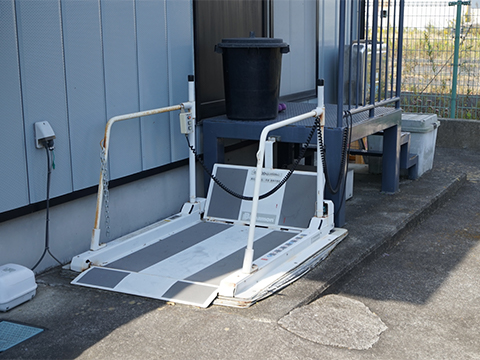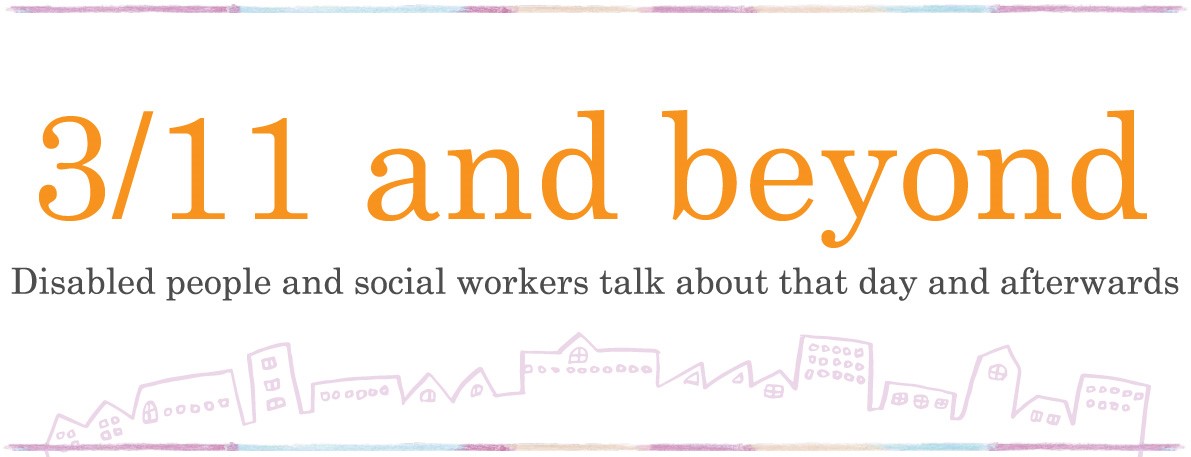 Story: Mr. Yoshichika Tobikawa (Male Man/ in his 40s at the time of the disaster/ SMA [spinal muscular atrophy])
Story: Mr. Yoshichika Tobikawa (Male Man/ in his 40s at the time of the disaster/ SMA [spinal muscular atrophy])Changes after the disaster
 Story: Mr. Yoshichika Tobikawa (Male Man/ in his 40s at the time of the disaster/ SMA [spinal muscular atrophy])
Story: Mr. Yoshichika Tobikawa (Male Man/ in his 40s at the time of the disaster/ SMA [spinal muscular atrophy])What would you say about relationship in neighborhood?
We meet and do things together regularly such as neighborhood barbecue about once a year.
So you have communication with them.
There was an occasion we had a quite strong aftershock and tsunami warning was issued. Neighbors shouted “Tobikawa-san! We need to escape!” before they were gone on their way. I was already on my bed and we thought it was too much for me to change clothes and get up from the bed, so we stayed at home in that occasion. We once escaped in my mother’s car, but there was very bad traffic congestion and we couldn’t even reach national highway nearby.
Have you had any new preparations or ideas for evacuation after March 11?
We will be able to escape if I’m on wheelchair like this. We will have to give up if I’m on my bed because it would take a long time to get myself ready. There is a lift in my room that we use to raise me up and put me onto the wheelchair. In that situation, I have to use that lift and stay up there to wait for the things to pass.
Did you install the sloped approach and the lift soon after the disaster?
The lift was installed about a month after the disaster with special permission. I couldn’t even come into the house without it. Sloped approach was made about two years after the disaster because if the electricity is cut we can’t use the lift.
Do you do community evacuation drills after the disaster?
They do but we don’t participate much. We think that we won’t have a place for us in the evacuation center, which is a local school. Instead, it would be better escape with family by car or stay in the house for a few days, or going to a school for the disabled. We heard various stories of persons with disabilities facing troubles at evacuation centers. They had to stay in a small corner of a huge room, had to bear not going to bathrooms, and couldn’t drink water. We think it might be much better if we escape ourselves to a welfare related locations such as school for the disabled instead of ordinary evacuation centers. Not all ordinary schools are barrier free. It would be good if people carry me up to the second floor of the evacuation center in case tsunami come, however, it would be a meaningless death for me if I push myself to go there and not being helped to die in tsunami.
Do you receive information on shelters for evacuees with disabilities?
Not much. I have heard about options at facilities for persons with intellectual disabilities, but I don’t feel like going there. I went to ordinary schools up to senior high school, and I kind of hesitate to go to schools for the intellectually disabled. There are not many of them either in Ishinomaki. Himawari is the only daycare facility in the city for persons with disabilities.
Has there been any change in your daily life after the disaster?
The life has come back to its original rhythm as seven years have passed. Only change is that I now bring my medications whenever I have to escape from house. I will put my medicines in the emergency bag and take it with me.
Was there any change about obtaining information?
I don’t think there was much change. There was an announcement of building an evacuation tower for persons with disabilities, but I don’t know what happened to that idea. There are not much high buildings here. It would be nice if we had one where people can have access with their wheelchairs.
I saw an evacuation tower in Watanoha district.
You’re right. But that one only has stairs, so we can’t go up on wheelchairs. I’ve heard that staff from a welfare center for persons with disabilities carried one person on wheelchair upstairs at that tower, and it took more than five minutes. People would give up carrying more persons on wheelchairs after that I guess.
A person on wheel chair can go upstairs with a help of one person pushing if the facility has a slope.
It would be nice to have a place for persons with disabilities to go when they need to evacuate. Not knowing where to go in emergency situation is very worrying. I wish we had easy to access information.
So, you would like to have information and related support, is it right?
I wish we had a booklet or a manual for persons with disabilities about what to do in case of natural disasters. They might already have one at the municipal office. We need specific local information of the area where we live. With that clear information, we will be able to take appropriate first steps. Both my mother and younger brother changed their cars to the ones with special sloped access for wheelchairs.
Is there anything new after the disaster about what you prepare or store for emergency? Say, for example storing water?
I take quite a lot of water usually, so we always buy bottled water by cases before the stock becomes empty. We also have some stock of food like instant noodles. We prepared an electric generator and a kerosene heater as well. With the generator, we can charge my wheelchair and our mobile phones. My late father worked in automobile business, and we know from his work the importance and usefulness of generators. That’s why we bought one to equip us for the time we need it.
How long does it take to recharge your wheelchair?
To fully charge from empty level, it takes about three hours.
How long does the battery last?
Well, if I use the wheelchair only inside the house, it lasts about one week. I have some spare batteries charged as well. When the battery is gone, the electric wheelchair is just a heavy wheelchair. At the time of that disaster, I was on this wheelchair, and moved myself while battery lasted. Once it was empty, I asked people to help and push it.
I guess the biggest problem is the difference in level.
That’s right. It’s difficult for me to go through without people’s help if the level difference is more than three centimeters. Newly built streets have level differences at the edge to prevent water, and it is very problematic for me. It is also difficult for me when the pedestrian path has a slant for making water goes down. Vibrations caused on cobbled streets are tough too. I imagine that slant on street is problematic to persons who use sticks as well.
It would be nice if the city of Ishinomaki picks some persons with disabilities for their opinions in case it plans to build new buildings such as civic hall. I joined a group called Nyokkiri-dan, which does activities related to this issue, because I think it is easier for an organization to bring our voice to the authority rather than an individual trying to do so.



